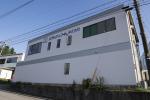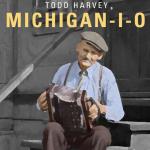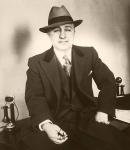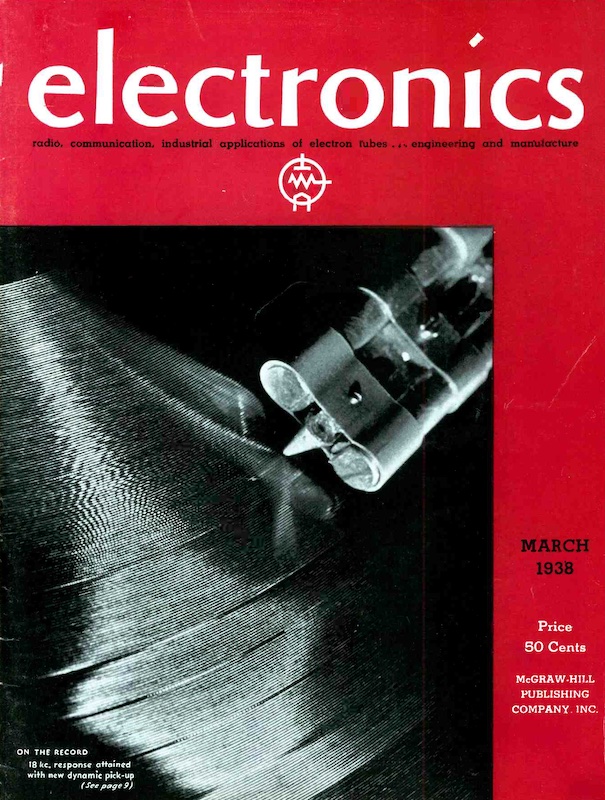前回 は、ストコフスキーのエピソードの他、横振動トランスクリプション、RCA/NBC が1939年に発表した Orthacoustic 特性など、あれこれについて調べました。
On the previous part, I studied on the interesting episode of Leopold Stokowski with Bell Telephone Laboratories, lateral transcription discs, RCA/NBC’s Orthacoustic characteristic, etc.
今回はその続きで、アセテート録音機の登場、業界を震撼させた技術論文、および現代につながる超軽針圧ピックアップの開発などについて学んでいきます。放送局トランスクリプション用である1942年NAB録音再生カーブの話まで、あともう少しです。
This time, I am going to continue learning the history, including an advent of instantaneous disc (lacquer) recorders, the technical paper that shook the industry, and ultra-lightweight reproducing pickups that definitely was the pioneer of the modern pickups we now use. This article is coming a few steps toward the 1942 NAB standardization (for electrical transcription discs).
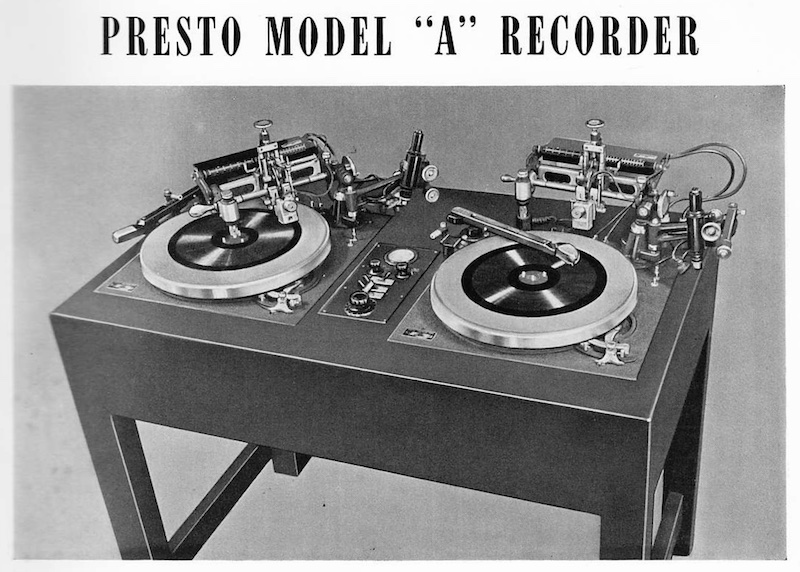
source: “Presto Recording Corp: Pioneers of ‘Instant’ Analog Disc Recording”, Preservation Sound website.
- 「Pt.0 (はじめに)」
- 「Pt.1 (定速度と定振幅、電気録音黎明期)」
- 「Pt.2 (世界初の電気録音、Brunswick Light-ray、ラジオ業界の脅威)」
- 「Pt.3 (Blumlein システム、当時のRCAやColumbia、民生用における高域プリファレンスの萌芽)」
- 「Pt.4 (Vitaphone、Program Transcription、Electrical Transcription、Bell Labs / Western Electric 縦振動トランスクリプション盤)」
- 「Pt.5 (ベル研とストコフスキーのエピソード、横振動トランスクリプション、Orthacousticカーブ)」
の続きです。
This article is a sequel to “Things I learned on Phono EQ curves, Pt.0”, “Pt.1”, “Pt.2”, “Pt.3”, “Pt.4” and “Pt.5”.
毎回書いている通り、筆者自身の学習過程を記したものですので、間違いの指摘や異論は遠慮なくお寄せください。
As I noted in every part of my article, this is a series of the footsteps of my own learning process, so please let me know if you find any mistakes on my article(s) / if you have different opinions.
今回も相当長い文章になってしまいましたので、さきに要約を掲載します。同じ内容は最後の まとめ にも掲載しています。
Again, this article become very lengthy – so here is the summary of this article (the same contents are avilable also in the the summary subsection).
1934年頃に英仏米の各社から、ニトロセルロースをアルミ盤に塗布したいわゆるラッカー盤(アセテート盤とも言われる)が発表。Presto のポータブル即時録音再生機(アセテート録音機)の大ヒットとあいまって、ラジオ業界、フィールドレコーディング、エアチェック、まれにプレスディスク原盤作成目的として、広く使われた。
From around 1934, several companies in UK, France and the US started distributing lacquer discs – aluminium discs coated with cellulose nitrate and other compounds. Along with the good sales of Presto’s portable instantaneous disc recorders, lacquer discs and disc recorders were widely used for instantaneous transcriptions in the radio industry, for field recordings, for airchecks, or sometimes even for making press masters for commercial discs.
代表的な Presto 1-B〜1-D カッターヘッドでは、裸特性に簡単な補正回路を加え、ベースターンオーバー周波数である 500Hz より下は定振幅、上は定速度の記録特性を得ていた。さらにそこに補正回路を加え、例えば放送局向けの Orthacoustic 特性(のちの1942年 NAB カーブ)を得ていた。記録特性の調整は基本的に回路改造で行われていた。
Typical cutting heads for instantaneous recorders at the time, Presto 1-B to 1-D, obtained the recording characteristic of “constant amplitude (6dB per octave slope) below 500Hz” and “constant velocity above 500Hz”, by adding a simple compensator network. Furthermore, with additional compensator network(s), Orthacoustic curve (for radio transcriptions, later becoming 1942 NAB curve) was obtained. Fine-tuning of the recording characteristic was made with circuit modification by soldering etc.
1938年に発表された Pierce & Hunt の論文で、高調波歪の点で横振動記録レコードの方が圧倒的に優秀であることが物理学的・数学的・科学的に証明された。同時にこの論文に関連して、当時としては超軽量な 1g〜5g という針圧で再生可能なピックアップ HP6A と HP26A も開発され、高品質な再生のためには針が溝の側面にサポートされた状態である必要があることが示された。これは、現在のレコード再生の基礎となる技術である。
The 1938 technical paper by Pierce & Hunt physically/mathematically/scientifically proved that the lateral-cut records were far superior to vertical-cut records: when properly reproduced in ideal situation, lateral-cut record produces far less distortion. Also along with that paper, they invented the ultra-lightweight pickup system HP6A (5 grams of needle force) and HP26A (1 gram); and they showed the groove’s sidewall support of the stylus is essential for high fidelity reproduction, which is one of the key technology of modern disc record reproduction.
Contents / 目次
6.1 Lacquer Discs and Instantaneous Recorders / ラッカー盤とアセテート録音機
前回 Pt.5 では 1939年の RCA/NBC Orthacoustic カーブ登場を扱いましたが、少し時代を遡り1934年、業界に起こった革命から始めます。
Part 5 of my entire article dealt with the RCA/NBC Orthphonic curve, introduced in 1939. Now I’m going to rewind the clock a bit – a revolution in the industry in 1934.
1933年〜1934年に、フランスの Pyral 社、英国の Marguerite Sound Studios、米国の Presto Recording Corporation の3者がほぼ同時期に、アルミニウム製の円盤にニトロセルロースを塗布したディスク記録メディア、いわゆる ラッカー盤 を開発します。
In 1933-1934, three companies – French company Pyral, British company Marguerite Sound Studios, and Presto Recording Corporation – began manufacturing so-called lacquer discs, aluminium discs coated with cellulose nitrate and other compounds.
当時の米国の市販用78回転プレス盤の原盤として主流であったワックス原盤より丈夫で、録音終了後すぐにピックアップで再生可能、数回程度の再生であれば盤を痛めることなく高品質な再生が可能なメディアです。ワックス原盤同様、プレス原盤として使うこともできます。
This instantaneous disc was: sturdier than wax discs (that was de facto standard as master discs for commercial 78rpm records); instantaneously playable with a reproducing pickup; able to provide high quality playback at least several times without destroying the recorded groove. Lacquer discs also can be used as master discs for pressing commercial records.
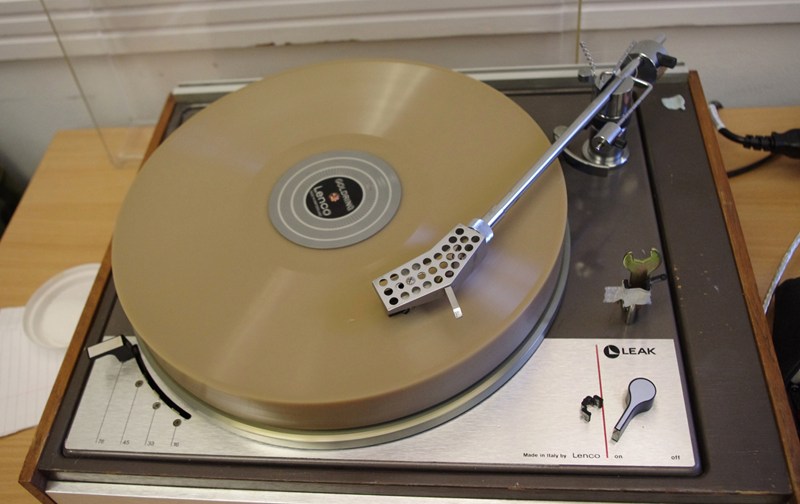
source: “The Art and Science of Acoustic Recording: Re-enacting Arthur Nikisch and the Berlin Philharmonic Orchestra’s landmark 1913 recording of Beethoven’s Fifth Symphony, Kolkowski, Miller, Blier-Carruthers, Science Museum Group Journal, Spring 2015 (online). © Aleks Kolkowski
1913年のニキシュ+ベルリン響のアコースティック録音 + ワックス原盤録音を再現する研究プロジェクトで復刻されたワックス原盤
a recorded wax disc, produced and used in the historical research to re-enact the 1913 acoustical recording of Nikisch and Berlin Philharmonic.
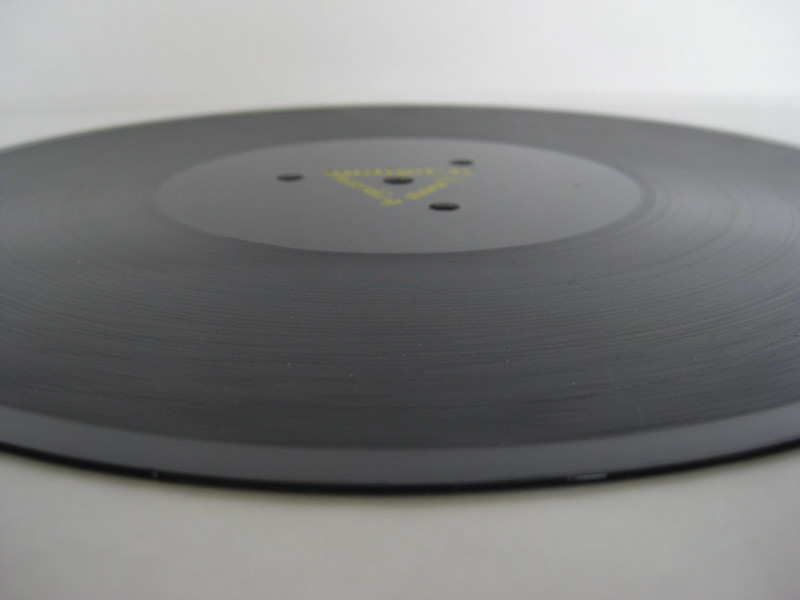
source: Preservation Self-Assessment Program: Phonograph Record and https://www.flickr.com/photos/betsian/4851969781/, by Betsian, CC BY-NC-ND 2.0
いわゆる「ラッカー盤」「アセテート盤」の一例
example of instantaneous “lacquer” disc
当時はまだ、放送業界やレコード業界の要求を満たすワイヤレコーダやテープレコーダが存在しておらず、ラッカー盤とディスク録音機は、即時録音・再生メディアとして、あっという間に米国市場に浸透しました。これら録音機は「インスタントディスクレコーダ」(Instantaneous Disc Recorder) または後に「ダイレクトディスクレコーダ」(Direct-to-Disc Recorder) と呼ばれました。日本語では「アセテート録音機」と呼ばれるのが一般的でしょうか。
Until the adoption of magnetic wires and magnetic tapes with high quality enough for the broadcasting / phonograph industries, lacquer discs and disc recorders soon gained popularity in the US for an instantaneous recording/playback purpose. These recorders are often called as “Instantaenous Disc Recorder” or later as “Direct-to-Disc Recorder”. In Japan, it is often called “Acetate Recorder”.
このアルミニウム + ニトロセルロース塗布のいわゆるラッカー盤が登場する直前に、セルロースアセテート(アセチルセルロース)を塗布した盤も存在しており、その名残から「アセテート盤」と言われるようになったとのことです。とはいえ、その名前の由来には諸説あるようで、Nicholas Bergh さんも次のように言っていました。
Actually, instantaneous discs coated with cellulose acetate were briefly used before the cellulose nitrate discs. This is why lacquer discs are frequently referred to as “acetate” to this day, although there are various theories why it is called “acetate” – here’s one thought by Nicholas Bergh-san:
The exact reason “acetate” came to be used for describing lacquers is unknown. In all cases it is incorrect technically, but it started very early (by late 30s) so one can’t get too upset by its incorrect use. One of the researchers on this topic is Dr. Michael Biel. He believes it was because there was also a pressed broadcast disc in the 1930s that was acetate that had some similar properties.
ラッカーを表す用語として「アセテート」が使われるようになった正確な理由は不明だ。いずれにせよ、技術的にはこの呼び名は間違っているわけだが。ともあれ、かなり初期から(1930年代後半までには)使われていた言い方なので、間違っていたとしてもあまり腹を立てるようなことではない。このテーマの研究者にマイケル・ビール (Michael Biel) 博士がいる。彼によると、1930年代にはアセテートでプレスされた放送用ディスクがあり、それが(ニトロセルロース塗布のラッカー盤と)似たような性質を持ったからだ、と考えている。
I should also note that the exact history of the lacquer disc is one of the big unknown in recording history. It appears that Presto licensed the technology from Pyral instead of developing it on their own. However, there were also some small brands in Hollywood making lacquer-like instantaneous discs in the early 1930s. More research needs to be done on this subject. The modern lacquer is mostly from Pyral I believe, though.
また、ラッカー盤の正確な歴史は、録音史の中でも大きな不明点の1つであることを記しておく。どうも、Presto は独自開発したのではなく、Pyral の技術をライセンスしてもらって製造していたようだ。しかし、1930年代初頭にはハリウッドでラッカー盤のような即時録音再生ディスクを製造していた小さなブランドがいくつかあったようだ。このテーマ(ラッカー盤の歴史)については、もっと研究が行われる必要があると思っている。現代のラッカー盤の技術はほとんど Pyral 社由来のものであると私は考えているが。
quoted from the email written by Nicholas Bergh to me on Nov. 17, 2022(少なくとも日本語では、即時録音・再生メディアとしては「アセテート盤」、プレスマスターとしては「ラッカー盤」、と区別して呼ぶのが通例なように思います。間違っていたらご指摘ください)
(at least in Japan, my understanding is that cellulose nitrate discs are called as “acetate discs” when used for instantaenous recording; “lacquer discs” when used for press masters – please let me know if my understanding is incorrect)
スイス視聴覚遺産保存協会 MEMORIAV が、ラッカー盤やアセテート盤などについての非常に詳細な資料(英語版とフランス語版)を公開しており、必読です。スイスの公共放送局 Radio Télévision Suisse (RTS) が管理する85,000枚のラッカーディスクコレクションに関する資料でもあり、またラッカー盤そのものの歴史、製造メーカによる組成のバリエーション、劣化状況、などについても詳細に解説されています。
MEMORIAV (Switzerland’s national network for the preservation of the country’s audiovisual cultural heritage) publishes a definitively detailed documentation on lacquer discs (English and French versions available) – highly recommended. This PDF document features 85,000 lacquer disc collection preserved by Radio Télévision Suisse (RTS), as well as a plenty of information (history, composition variation, deterioration, etc.) of lacquer discs.
当時の米国におけるプロフェッショナルユース(市販の78回転レコード用)では、Scully 社製のカッティングレースがほぼ業界標準で、これに様々なメーカのカッターヘッドが取り付けられ使われていました。当連載でも何度も出てきた Western Electric のラバーラインレコーダ(ワックス原盤用)もそうでした。
In the US, Scully cutting lathes were de facto standard for professional recording purpose (of commercial 78rpm records), with several variations of cutterheads were used with them. One of such cutterheads was, as I frequently mentioned in previous parts of my entire article, Western Electric (Westrex) “rubber-line” recorder (for wax disc recording).
また、RCA や他レーベルによるクローンのラバーラインレコーダ、トランスクリプション用カッターヘッド、そして Presto カッターヘッド、その他いろいろなカッターヘッドが録音スタジオで使われていたそうです。
Some “clone” rubberline recorders by RCA or other labels/studios were also used; other cutterheads for electrical transcriptions, Presto cutterheads, and some others were also used in the studios.
ともあれ、プロフェッショナルユースのカッティングレース以外に、廉価でポータブルなカッティング機材が出回り出し、選択肢が増えたことで、
- ラジオ局にとって、プレスされたトランスクリプション盤だけに頼らずとも、手軽にラッカートランスクリプション盤を制作し利用可能になった
- しかも放送局での使用に充分に耐える(当時としては)音質での録音が可能であった
- 一部のコアなリスナーにとって、(テープが登場するまでの間)ラジオ放送を録音するなどする用途に重宝された
- 市販の78回転シェラック盤よりも再生周波数帯域が広くサーフェスノイズも少なく(当時としては)高音質再生可能であり、テープが登場するまではフィールドレコーディングなどで広く使われた
- ワックス原盤と異なり、記録したラッカー盤は即時再生も可能(とはいえ、再生すればするほど高域成分が劣化し、ノイズも増える)だが、銀メッキ+ニッケルメッキを施してマスター盤を生成しさえすれば、通常のプレス盤制作を行うことも可能であり、小さなスタジオでも(品質はさておき)プレス用のディスクカッティングを自前で行えるようになった
など、業界にとって大きなインパクトがありました。なにより、テープ録音が一般的になる前の、一時的な「即時録音再生機」としての需要が大きかったと言えます。
Anyway, in addition to professinal lathes and recording heads, the emergence of less expensive (and sometimes portable) recording equipments brought many merits and impacts, such as:
- Radio stations became able to cut their own instantaneous transcription discs, in addition to pressed electrical transcriptions
- Instantaneous lacquer discs could play high fidelity (at that time) that meets requirements for radio broadcast
- For some amateurs, portable/instantaneous disc recorders were very useful and helpful for recording broadcasted programs, etc.
- It could play wider frequency range with lower surface noise than shellac 78rpm discs – “high fidelity” (at that time) enough; frequently used for many situations such as field recordings, until the tape recorders became popular
- Unlike wax masters, cellulose nitrate discs can be instantaenous played back (although several playbacks with heavy pickups would lead high frequency loss and surface noise increase); also, by plating silver/nickel, it can also be used as lacquer master discs for pressing commercial records; low-budget small studios could do cutting for commercial 78rpms discs (apart from the sound quality)
The most important role of it was an “instantaneous recorder and player” until the magnetic tape recorder became popular.
アセテート録音機の世界で、米国で圧倒的な存在感を示したのが Presto Recording Corporation でした。1934年に発表された Presto 6D 録音機、そして1941年の後継機 Presto 6N 録音機は共に大ヒットとなり、ニトロセルロース塗布ラッカー盤(ブランクディスク)は大量に売れました。1938年には、米国で Audio Devices 社による Audiodisc というラッカー盤も登場しました。
In the instantaneous recorders field, Presto Recording Corporation showed its overwhelming presence. Presto 6D recorder (1934), and its successor Presto 6N recorder (1941) scored huge success; Presto’s cellulose nitrate “blank” discs sold well. Also in 1938, Audio Devices started manufacturing and selling blank discs called “Audiodisc”.
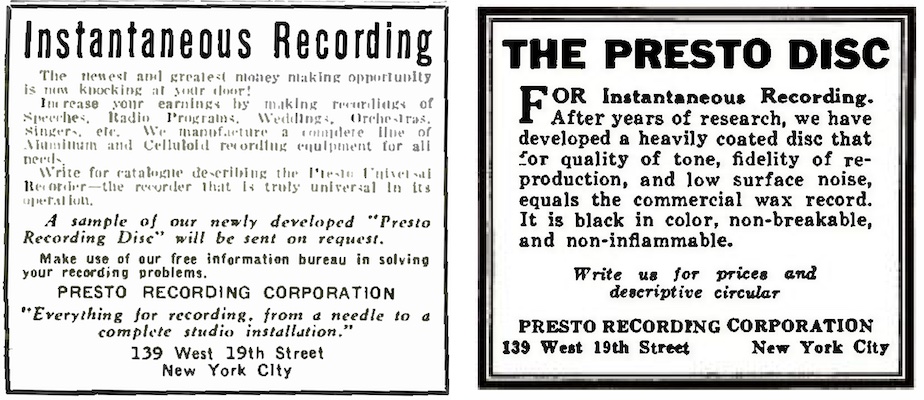
source: Presto Recording Ads on Radio Craft magazines, July 1934, p.40 (left) and October 1934, p.238 (right).
Radio Craft 誌の1934年7月号 (左) と 10月号 (右) に掲載された Presto ラッカー盤の広告
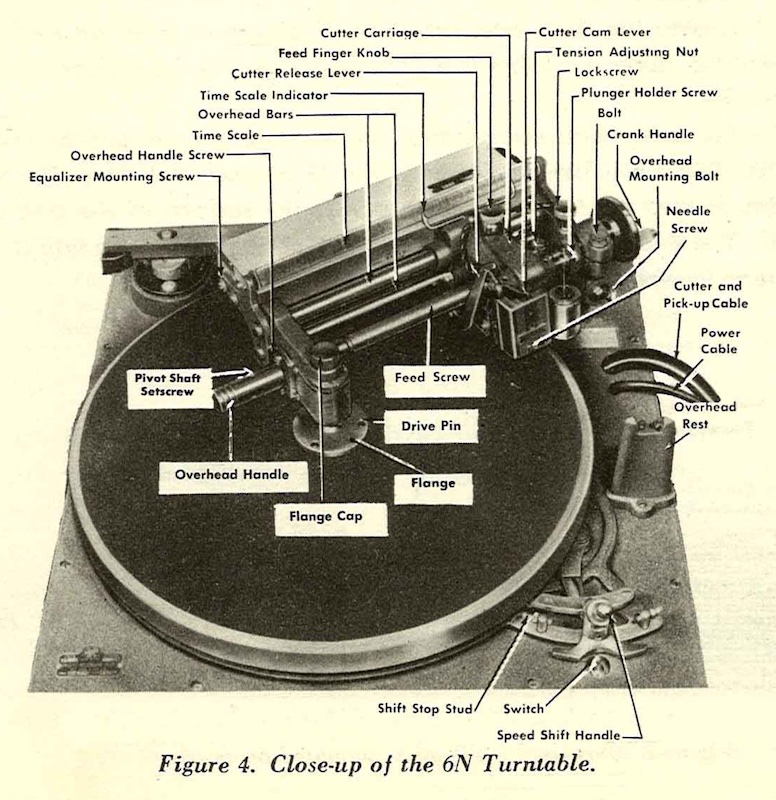
source: “Operating Instructions for Presto 6N Recording Turntable”
Presto 6N 取扱説明書に掲載された図版
そういえば、有名な アラン・ローマックス (Alan Lomax) による膨大な量のフィールドレコーディングも、Presto 6D 録音機で行われました。
By the way, that famous field recordings by Alan Lomax was done with the Presto 6D recorder.
In 1938 the Library of Congress dispatched the pioneering folklorist and song collector Alan Lomax to conduct a folklife survey of the Great Lakes region. He traveled in a 1935 Plymouth sedan, toting a Presto instantaneous disc recorder and a movie camera. And when he returned nearly three months later, having driven thousands of miles on barely paved roads, it was with a cache of 250 discs and 8 reels of film, documents of the incredible range of ethnic diversity, expressive traditions, and occupational folklife in Michigan.
1938年、米国議会図書館は、民俗学の先駆者にして歌の蒐集家であるアラン・ローマックスを、五大湖周辺の民族調査のため派遣した。ローマックス氏は、Presto 社製アセテート録音機と撮影機を1935年式のプリムスセダンに積み込み、旅に出た。そして約3ヶ月後、まだ舗装もされていなかったルートを何千マイルも走破して戻ってきた時、プリムスセダンには250枚の録音ディスクと8リールのフィルムが積まれていた。
The Library of Congress: Alan Lomax and the Soundscapes of the Upper Midwest: 75th anniversary of the 1938 Library of Congress Folk‐Song Expedition to Michigan Episode 4 Title: “Michigan‐I‐O”6.1.1 Presto Cutterhead Frequency Response / Presto カッターヘッドの周波数応答特性
さて、この Presto 6D や 6N といったアセテート録音機で使われたカッターヘッドの代表例が、1937年の Presto 1-B、および 1939年の 1-C、さらに 1949年の 1-D です。幸い、これらのマニュアルや周波数応答特性グラフなどが残されています。
The cutterheads (cutting heads) often accompanied with such recorders as Presto 6D and 6N were: Presto 1-B (1937), 1-C (1939) and 1-D (1949). Fortunately, many documentations survive, including instruction manuals, technical papers, etc.
Communication and Broadcast Enginering 1937年3月号の記事 “An Instantaneous Recording Head” にて、型番は記されていないものの、Presto 1-B と思われるカッターヘッドの周波数応答特性グラフが掲載されており、記録可能な周波数の上限が 7,000Hz であることなどが記されています。
The first one is an technical article “An Instantaneous Recording Head”, published in the Communication and Broadcast Engineering, March 1937 issue. No model number specified in the article, but highly possibly it is 1-B. The article also presents the frequency response graph of the cutterhead, with the maximum recorded frequency being 7,000Hz.
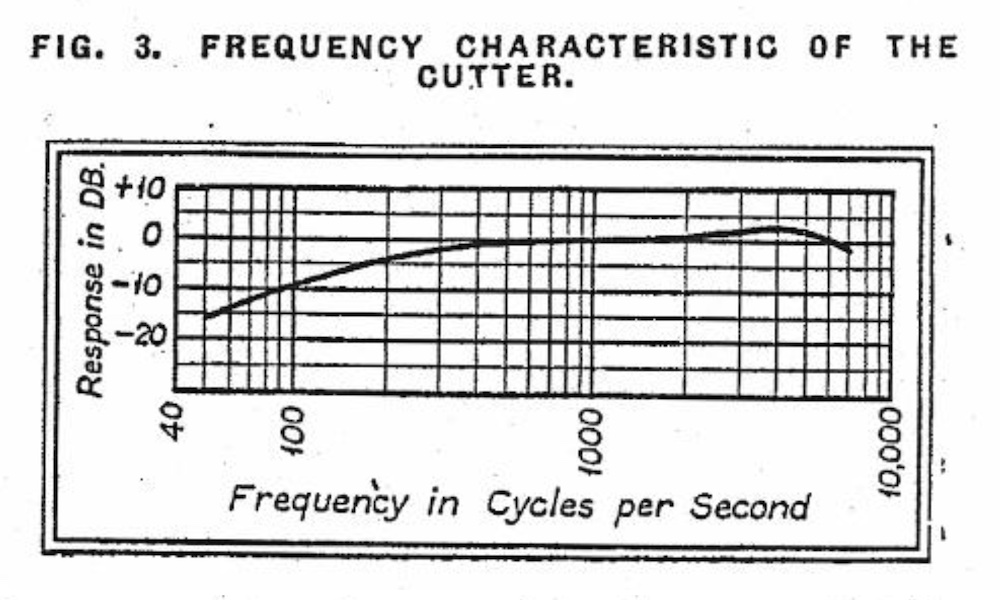
source: “An Instantaneous Recording Head”, George J. Saliba, Communication and Broadcast Engineering, March 1937 (archived at World Radio History), p.8
Presto チーフエンジニアによる、1-B カッターヘッドについての解説記事
1-B technical article, authored by the Presto’s chief engineer
この周波数応答特性グラフからは、500Hz あたりに低域ターンオーバー周波数が設定されていることが読み取れるものの、500Hz 以下のスロープが定振幅(周波数が半減すれば-6dB)には至っていないことがわかります。
This frequency response graph shows the cutter has 500Hz bass turnover frequency, while the slope below 500Hz is not constant amplitude (6 dB per octave) – instead, a kind of 3 dB per octave.
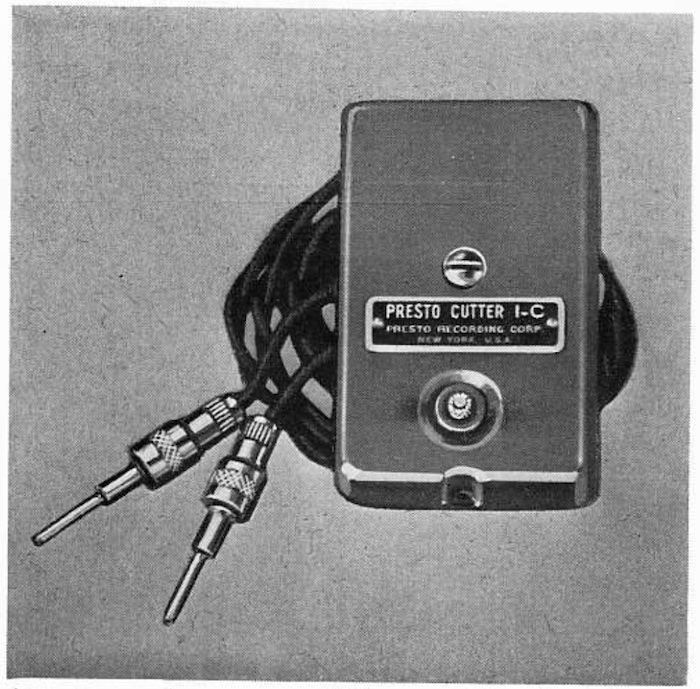
source: “Presto Recording Corp: Pioneers of ‘Instant’ Analog Disc Recording”, Preservation Sound website.
1940年 Presto カタログに掲載された 1-C カッターヘッド。記録周波数帯域は 50Hz〜8,000Hz と記されています。
Presto Type 1-C Cutting Head from Presto 1940 Catalog. Frequency response from 50Hz to 8,000Hz.
そこで次に参考になるのが 1949年に登場した 1-D (記録可能な周波数の上限は 10,000Hz まで伸びている)の マニュアル で、録音用パワーアンプと 1-D カッターの間に補正回路(録音用イコライザ)をはさみ、当時の78回転用市販レコードで標準となる記録特性を実現しています。
Then the Presto 1-D Recording Head Instruction is helpful to understand how the discs were cut with the Presto cutterhead. In this instruction manual, a compensator network circuit (between the recording amplifier and the cutter) is presented to obtain the 6dB per octave slope below the turnover frequency, that was common among the commercial 78rpm discs in the US.
The normal response range of the 1-D head extends from 50 to 10,000 cycles per second. Recording made with this head are of constant amplitude below the cross-over frequency of approximately 500 cps, and of constant velocity above 500 cps for constant input at all frequencies into the recording amplifier.
Presto 1-D カッターヘッドの通常応答周波数帯域は、50Hz〜10,000Hz である。このカッターヘッドを使って録音すると、約500Hzあたりをクロスオーバー周波数として、それ以下の帯域が定振幅(に近い)特性、そしてそれ以上の帯域が定速度特性となっている。
To obtain a 6 db per octave slope of the velocity versus frequency characteristic below the crossover point requires the use of a 1-D head in series with a simple network across the amplifier output (figure 2). For a 15-ohm head this network is a three-ohm series resistor, whereas a parallel combination of a 180-ohm resistor and a 4-mfd capacitor is used in series with the 500-ohm head. The average frequency response obtained with these values for the elements of the compensating netowrk is shown in figures 3 and 4. (…) To realize the full possibilities in recording with the 1-D cutting head, the playback characteristic chosen should be complementary to the cutter frequency response.
クロスオーバー周波数以下において、(標準的な録音特性であり、真の定振幅である)1オクターブにつき 6dB のスロープを実現するには、録音用アンプとカッターヘッドの間に、図2のようなシンプルな回路を挿入する必要がある。15オームのヘッドの場合は、3オームの抵抗を直列に挿入し、500オームのヘッドの場合には、180オーム抵抗と4マイクロファラドのコンデンサを並列にし、それを直列に挿入する必要がある。これらの補正回路によって実現される応答周波数の平均値を図3と4に示す。 (…中略…) 1-D カッターヘッドの記録性能を最大限享受するには、ここで設定したカッターヘッドの応答周波数特性に対応する再生用特性を実現する(補正回路を用意する)ことが必要となる。
Instructions for 1-D Recording Head, Presto Recording Corp.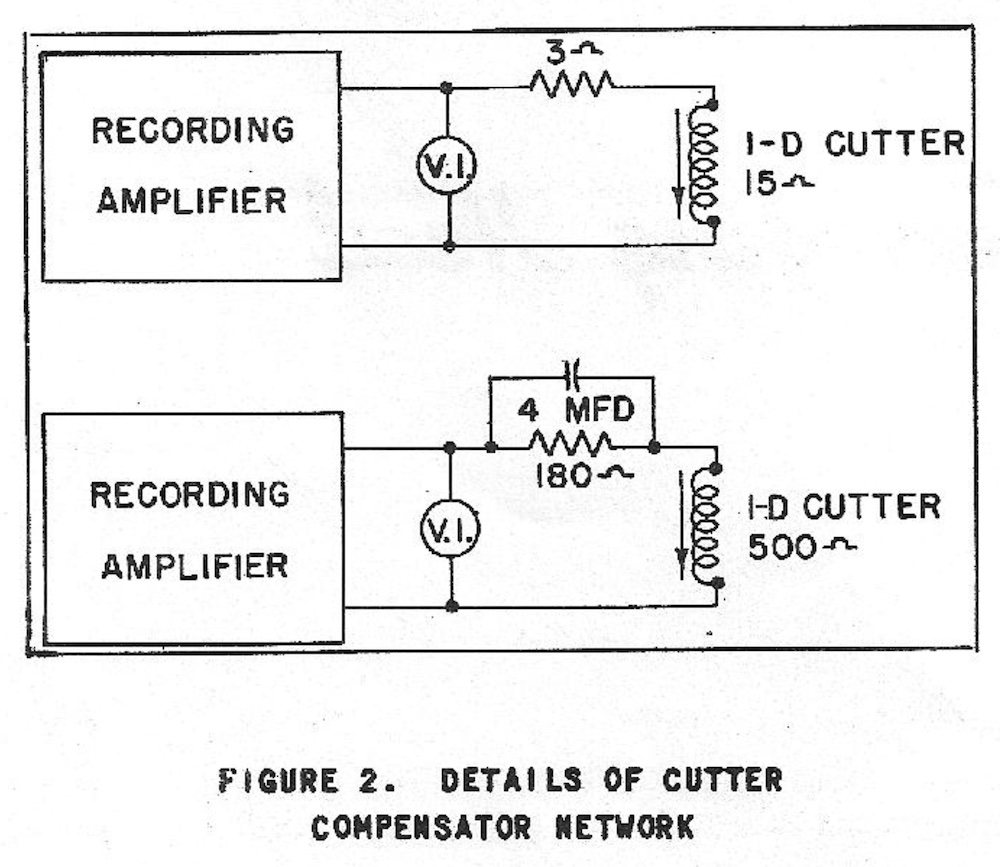
source: “Presto Recording Corp. 1-D Recording Head Instructions,
標準的な1オクターブにつき6dBスロープにするために、カッターヘッドの特性に加え、この図のような追加の補正回路が必要
a simple network between the amplifier and the 1-D cutterhead to obtain standard slope
Presto 1-D カッターヘッドに存在する 15オーム版と 500オーム版の違いについて、議論している web フォーラム を見つけました。
I happened to find the web forum thread discussing the difference between the 15 ohm version and the 500 ohm version of the Presto 1-D cutterhead.
つまり、これら Presto アセテート録音機においては、カッターヘッドの裸特性 + シンプルな補正回路によって、Bell Labs / Western Electric / RCA のラバーラインレコーダなどが実現していた「ターンオーバー周波数 500Hz」「500Hz 以下は 6dB スロープの定振幅」「500Hz 以上は定速度」という記録特性を実現していたことになります。
So, the fact is that the recording characteristic of “bass turnover frequency at 500Hz”, “constant amplitude (6dB per octave slope) below 500Hz”, and “constant velocity above 500Hz” (that was the same characteristic as Bell Labs / Western Electric / RCA and some others had) was accomplished by the combination of uncompensated frequency response of the cutterhead and the simple compensator network.
そして、必要に応じて、さらに重低域や高域の補正回路を追加し、Orthacoustic カーブ(のちの 1942 NAB 録音カーブ)にして使われていたことになります。
Then, when necessary, additional compensator network(s) in the lower bass region and/or in the treble region was applied to obtain the Orthacoustic (or soon-to-be 1942 NAB) recording characteristic.
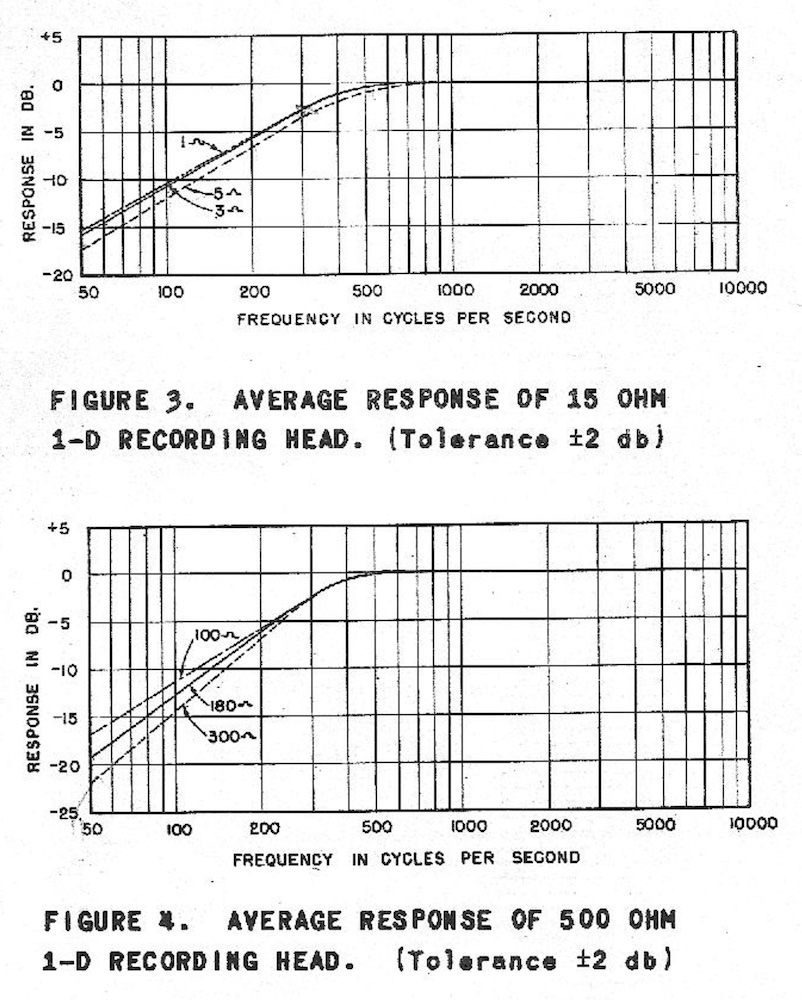
source: “Presto Recording Corp. 1-D Recording Head Instructions,
15Ω版と500Ω版の 1-D でそれぞれ最終的に得られる記録特性
低域ターンオーバ周波数である500Hzより下は定振幅、上は定速度での記録となっている(誤差±2dB)。
一方、1942年に放送局用NAB標準カーブが採択されるまでは、この補正回路を独自改造したり、同様に高域補正回路を追加するなどして、思い思いの録音カーブにして使っていたことになります。本来の使われ方である「即時録音再生」であれば、記録特性に対応する再生特性回路を自ら用意することができますが、放送局向けにカッティングした場合、そのカーブは録音されたエンジニアや機器によって千差万別となり、放送局が受け取ったラッカー盤(アセテート盤)を再生する際にどういったパラメータを使えばいいのか、まったく統一されていなかったと推測される所以です。
On the other hand, until the wide adoption of the standardization “1942 NAB recording/playback curve”, users of these instantaenous recorders/cutterheads might modify the compensator networks (or applied additional compensator networks), to accomplish his/her preferred recording curve. For an closed instantaneous recorder and player use, the modifier can also prepare the playback compensator network that is complementary to the recording characteristic. But once the lacquer transcription discs were delivered to radio stations, broadcast engineers had to prepare several variations of playback conpemsator networks for various lacquer transcription discs, recorded with various recording characteristics. This would probably lead to the necessity of the standardization of recording/reproducing characteristic in the broadcast industry.
もちろん、現代の可変イコライザ付きフォノイコのように、ノブをまわして簡便にカーブを修正する、などという使い方はされていなかったはずです。カッティングレースやカッターヘッドに付属する録音用イコライザを無修正でそのまま使うか、テストカットを繰り返し計測し、録音用イコライザを半田付けなどで改造するなどして、エンジニアが狙ったカーブで記録できるように改造していたと思われます。
Of course, there was no such recording amplifier (or equalizer) at that time, as having features of conveniently switching turnover frequencies and gain (like modern variable phono preamps). I guess some engineers might use preconfigured compensator networks unmodified; some others might do trial-and-errors by test-cutting, calibrating, modifying compensator network by soldering, to accomplish the desired recording curve.
以下は、1949年の 1-D カッターヘッドのマニュアルに記載されている内容で、1949年 NARTB カーブ(= 1942年 NAB カーブ、すなわち Orthacoustic カーブ)の計測を行う際の注意点が書かれた箇所です。Presto 社のレコーディングアンプを使わない場合は、自前で録音補正回路を用意し、この情報を参考に記録特性を計測チェックしていたということになります。
Below is the description in the 1949 1-D cutterhead instruction manual, of how the 1949 NARTB characteristic (= 1942 NAB characteristic = Orthacoustic curve) can be measured and obtained. Engineers who did not use Presto’s recording amplifiers might develop their own compensator networks then test-calibrated, by using this description as a reference.
A check on the equalized recording characteristic (NARTB) should never be made with the input to the amplifier kept constant. This would lead to an output rise of about 16 db above the 1000-cycle level at 10,000 cps and damage to the cutting head may result. Such an overload cannot occur during recording of any actual sound program, since peak energy levels at higher frequencies are about 20 db blow peak energy in the middle audio-frequency range.
イコライズされた録音特性(NARTB)をチェックする際、アンプへの入力を一定にした状態では絶対に行わないこと。1,000Hz の出力に比べ 10,000Hz の出力が 16dB も上昇するため、カッターヘッドを破損する恐れがある。実際の音楽番組の録音においては、中音域のピークエネルギーに比べ、高域のピークエネルギーは -20dB 程度となるため、このような過負荷は起こらない。
In making this equalized run, the attenuator between the oscillator and the recording amplifier should be of the variable type with fixed known loss between points. The amount of attenuation between the oscillator and the recording amplifier should be reduced by an amount equal to the rise in the equalizer characteristic for any particular frequency. For example, if the equalizer characteristic shows an increase of 4 db at 2000 cps above the 500-cps level, the attenuation should be increased by 4 db at 2000 cps. The result of this decrease in amplifier input and the complementary rise in the amplifier frequency characteristic, because of equalization, will be a flat recorded pattern.
この周波数特性チェックにおいて、オシレータと録音アンプの間のアッティネータは、各ポイント間の損失が固定で既知のバリアブルタイプを使用すること。オシレータと録音アンプの間に発生するある特定の周波数における減衰量は、同じ周波数に対するイコライザの増幅量と同じにする必要がある。例えば、イコライザ特性が 500Hz に比べて 2,000Hz で +4dB となる場合、アッティネータでは 2,000Hz で -4dB とする必要がある。アンプへの入力が減少した分、イコライジングによる増幅が行われることで、結果としてフラットな記録パターンとなる。
Any deviation from a uniform characteristic (above the crossover point) indicates an incorrect equalizer curve if the previous frequency run with the amplifier in the flat position shows the cutting head itself to have the correct frequency response.
クロスオーバーポイントより上における均一な特性からのずれは、アンプをフラットポジションで実行した事前に行った計測が正しくカッターヘッド自体の周波数特性を示している場合、イコライジングカーブ(を実現する補正回路)が正しくないことを示していることになる。
Presto Recording Corp. 1-D Recording Head Instructions一方、1940年当時の Presto 社製レコーディングアンプには、3つの録音ポジションからなるセレクタがついていました。いわゆる 500N-FLAT(通常の78回転レコードと同じ)、RCA/NBC Orthacoustic(Pt.5 で紹介した、RCA/NBC が提案した新しい録音カーブ、のちに NAB カーブになる)、そして FLAT(全周波数帯域で定速度特性記録、キャリブレーション用)でした。
On the other hand, Presto’s recording amplifier 88-A in 1940 had a rotary switch with three positions for three recording characteristic: one for commercial 78rpms (500N-FLAT), one for RCA/NBC Orthacoustic, and the other for FLAT (constant velocity throughout all frequencies, for testing purpose).
当然ながら、現在の可変カーブ再生フォノイコのように「ターンオーバー」「ロールオフ」切り替えではありませんでした。以下の引用は1940年カタログの Presto 88-A アンプの仕様です。
Of course, it was not a switch for “turnover” and “rolloff”. Below quote is from the Presto’s 1940 Catalog, on Type 88-A amplifier.
The Presto 88-A is the first recording amplifier capable of standardizing the frequency response of instantaneous recording so that they will complement exactly the characteristics of the high fidelity reproducing equipment now used in most broadcasting stations. Transcriptions made with the 88-A amplifier and Presto 1-C cutting head will reproduce uniformly a range from 50 to 9,000 cps, when played back on Presto, Western Electric or RCA reproducing equipment.
Presto 88-A は、アセテート盤の周波数応答特性を標準化可能な初の録音アンプであり、ほとんどの放送局で使用されている高音質再生機器向けの特性に補正を行う。88-A アンプと 1-C カッターヘッドの組み合わせでカッティングされたアセテート盤は、Presto、Western Electric、または RCA の再生機器で再生した場合、50Hz〜9,000Hz の帯域においてフラット特性を得ることが可能となる。
Frequency Response: Pos. 1, uniform within 1 db from 20 to 17,000 cps; Pos. 2, complements the NBC Orthacoustic playback system; Pos. 3, complements the standard high fidelity lateral playback system.
周波数特性: セレクタ1, 20Hz〜17,000Hz でフラット (誤差 1dB)。セレクタ2, NBC Orthacoustic 再生システム向けの補正回路。セレクタ3, 通常の高音質横振動再生システム向けの補正回路。
Controls: Selector switch for frequency response, gain control and power switch.
操作系: 周波数応答切替用セレクタスイッチ、ゲインコントロール用セレクタスイッチ、および電源スイッチ。
Presto Recording Corp: Pioneers of ‘Instant’ Analog Disc Recording注意する必要があるのは、このアンプの補正回路は Presto 1-C カッターヘッドと組み合わせれることを前提としている、という点です。上でみてきた通り、Presto 1-B、1-C、1-D カッターヘッドはフラット特性ではないので、カッターヘッドの特性 + アンプの補正回路の特性 = 録音特性、ということになります。
The important thing to notice is, that this amplifier and its compensator network is supposed to use with Presto 1-C cutterhead: as we have seen above, the uncompensated frequency response of Presto 1-B, 1-C and 1-D is not flat in velocity. So the “cutterhead frequency response” + “characteristic of amplifier’s compensator network” = “recording characteristic”.
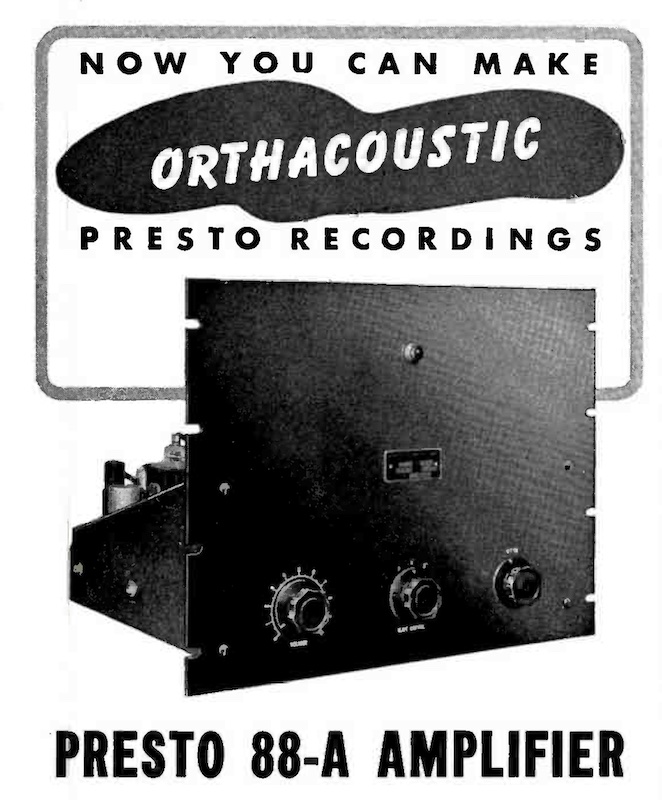
source: Presto Recording Ads on Broadcast magazine, February 3, 1941, p.24
Broadcast 誌 1941年2月3日号に掲載された、Presto 88-A アンプの広告より
6.1.2 Presto Cutterhead Used in the Recording Studio / 録音スタジオで使われる Presto カッターヘッド
Nicholas Bergh さんによると(いつも丁寧に教えてくださりありがとうございます)、1930年代〜1940年代の市販用78回転レコードのカッティングに使われていたレース(ターンテーブル)はほとんどが Scully 製だったそうですが、Western Electric 製カッターヘッドが高くて使えない中小の録音スタジオでは Presto 社製などいろんなカッターヘッドが装着されていたそうです。
According to Nicholas Bergh (thank you so much like always for kindly letting me know), most of the lathes used for commercial 78rpm records in the studios of 1930s-1940s were Scully, while many variations of cutterheads were used with the Scully lathes at many studios not wealthy enough for Westrex.
(…) Regarding Presto, I have a lot of that equipment and information. Many important recordings were made on Presto equipment, but it was not commonly used for music recording. Mostly for broadcast or ethnographic related work. For example, the Hindenburg crash recordings were done on a Presto 6D. Presto is puck drive so it can have rumble compared to professional disc machines. It is also more awkward to change the cutting pitch. For broadcast this did not matter. They can sound very nice, though. (…)
(…) Presto 社製カッティングレースは、自分は機材の現物をたくさん所有しているし、資料もたくさん持っている。Presto 社製カッティングレースで多くの重要な録音が行われたが、市販78回転レコード用の音楽録音ではあまり使われていなかった。そのほとんどは放送目的の録音か、民俗学史的な記録録音だ。例えば、ヒンデンブルグ号の爆発事故の録音は Presto 6-D で行われた。Presto はパックドライブ(リムドライブ)だったので、プロフェッショナルユースのカッティングレース(ダイレクトドライブ)に比べてランブルノイズが乗りやすかった。また、カッティングのピッチ変更も非常に難儀だった。一方、放送目的の録音ではあまり問題にならなかった。良い音質での録音はできていた。 (…)
(…) The cutting head situation was a little different than the lathe situation. The Grampian did not come to America until the 1950s and was widely used at most studios not wealthy enough for Westrex. As far as independent studios go, many different mono heads were used. Some studios like Capitol even used Presto heads on Scully lathes early on. The Presto was better than most of the commercial RCA heads available. (…)
(…) カッティングレースと、カッターヘッドでは、状況が少し違った。Grampian カッターヘッドは1950年代になるまではアメリカに導入されなかったが、それ以後は Westrex カッターヘッドを導入する予算がない多くのスタジオで広く使われるようになった。独立録音スタジオにおいては、さまざまなモノーラルカッターヘッドが使われていた。例えば Capitol などのスタジオでは、初期から Scully レースに Presto カッターヘッドを組み合わせて使っていた。当時(トランスクリプション用に)RCA が製造販売していたカッターヘッドより、Presto のカッターヘッドの方が性能が良かったからだ。 (…)
quoted from the emails written by Nicholas Bergh to me on Nov. 9 & 10, 2022その他、私が見つけたものとしては、1947年にニューヨークで設立された Mary Howard Recordings スタジオの情報がありました。元々クラシックのヴァイオリニストであった Mary Howard さんが1940年に NBC に入社、第二次世界大戦中で人手が足りなくなり、当時は男性の仕事であった録音エンジニアを担当できるようになり、戦後に独立されたスタジオです。Audio Record 誌 1948年2月号に「録音エンジニアとして活躍する女性」として紹介されていました。その中で、市販用78回転レコード向けの録音機材について記されていました。
Other information I could find was on the Mary Howard Recordings studio, established in 1947, New York. Mary Howard, who was a classically trained violist, applied for an engineer’s job at NBC in 1940. During the WWII, NBC was losing man after man to the armed forces, then she could become a master recording engineer. Then after the WWII, in 1947, she opened her own recording studio. This episode was from the “Audio Record” magazine, February 1948 issue. The article also features the recording equipment she used for commercial 78rpm disc recordings.
Mary Howard Recordings functions primarily as a recording service and its operations, besides cutting instantaneous masters, including line and air checks of all descriptions, studio recording and sidefilm work. In the last year Mary Howard Recordings released their own commercial records. The Herman Chittison Trio, Ethel Waters, Lucille Turner and Dale Belmont are few of the artists who made recordings under the MHR label. And, like the thousands of other recording companies, Mary Howard Recording is waiting patiently for the Petrillo ban to be lifted so they can ‘get going’ again.
Mary Howard Recordings スタジオは、主に録音サービスに従事しており、その業務は、即時録音(アセテート)マスターのカッティングのほか、あらゆる内容のラインチェックやエアチェック、スタジオ録音、サイドフィルムの仕事などを行なっている。昨年(1947年)、Mary Howard Recordings は自社製の市販(78回転)レコードをリリースした。MHR (Mary Howard Recordings) レーベルからリリースされたそれらの盤には、Herman Chittson Trio や Ethel Waters、Lucille Turner そして Dale Belmont などが含まれる。そして、他の何千ものレコード会社がそうであるように、ペトリロ禁止令(レコーディングストライキ)がはやく解除され、再び商用録音を再開できるようになる日まで、辛抱強く待っているのである。
Cutting equipment in Mary Howard Recordings, according to Chief Engineer Don Plunkett, Mary Howard’s able assistant consists of: Van Eps and Allied Cutting Lathes, Presto 1-D Heads driven by Langevin 101-A Amplifiers. “Our mixing equipment,” Mr. Plunkett explained, “is interchangeable by means of patching. Our Preamps and Our Program Amps are Langevin. Re-recording equipment at MHR,” Mr. Plunkett said, “consists of Allied Transcription Tables and Pickering Reproducing Equipment, which have served us most efficiently of all pickups we have tried. This combination – Allied TT’s and Pickering Pickups – we find the most flexible for composite recording.”
Mary Howard Recordings のチーフエンジニア Don Plunkett によると、Mary Howard 女史の有能なアシスタントとも言えるカッティング機材は、Van Eps と Allied のカッティングレース、Presto 1-D カッターヘッド、Langevin 101-A アンプであると言う。Plunkett 氏は続ける。「我々のミキシング機材は、パッチで交換可能なようになっている。プリアンプとプログラムアンプは Langevin 製だ。再録音(ダビング)に使う機材は、Allied のトランスクリプションテーブルと Pickering 再生ピックアップで、試したあらゆるピックアップの中で最も良いと選定したものだ。Allied トランスクリプションテーブルと Pickering ピックアップの組み合わせは、ダビング時に最も柔軟性を備えていると考えている。」
The War Gave Mary Howard Her Big Chance to Make Good in Recording; She Did - And How!, Audio Record, February 1948, pp.1 & 4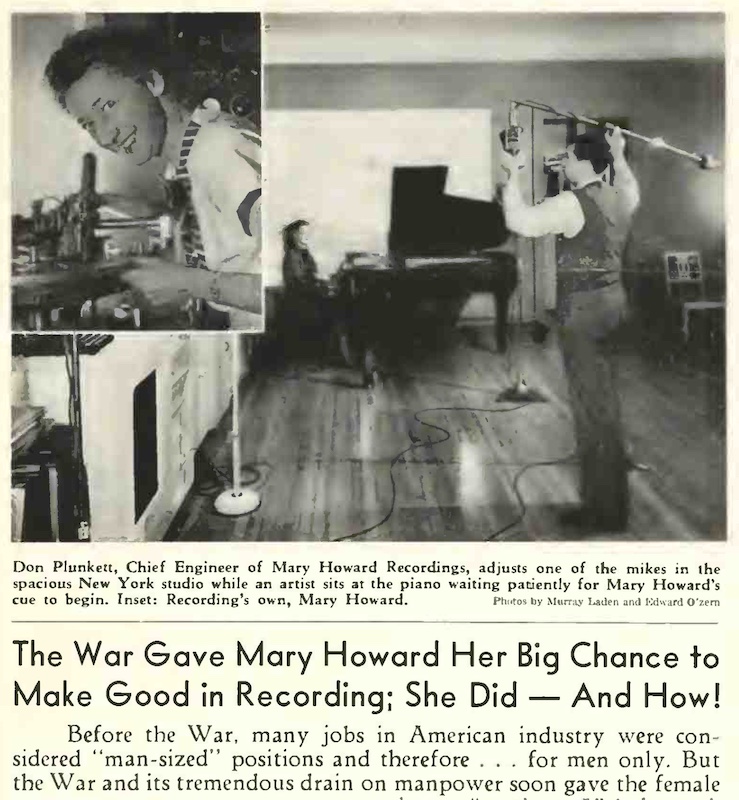
source: “The War Gave Mary Howard Her Big Chance to Make Good in Recording; She Did – And How!”, Audio Record magazine, February 1948, p.1
Audio Record 誌1948年2月号で特集された Mary Howard と彼女の録音スタジオに関する記事の冒頭
もちろん、というか、残念ながら、というか、どのようなイコライザを使って、どのような録音特性でカッティングされていたか、などに関する記載はありません。
Of course, or, unfortunately, there is no mention about the recording characteristic, as well as what kind of equalizer/compensator was used.
6.2 The paper that shooked the industry / 業界を震撼させた論文
ここでガラッと話を変えて、当時の再生機材の進化について興味深い話を見てみましょう。
Now let’s move to another interesting episode, although the topic is entirely different – evolution of playback/reproducing equipments.
JSMPE (Journal of the Society of Motion Picture Engineers) の1938年8月号 (Volume XXXI, Number 2) に、とある技術論文が掲載され、レコード業界を大騒ぎさせました。
August 1938 issue (Volume XXXI, Number 2) of the JSMPE (Journal of the Society of Motion Picture Engineers) contained a certain technical paper that eventually shooked the phonograph industry.
その論文は、ハーバード大学の Cruft 研究所の2人、John Alvin Pierce 氏と Frederick Vinton Hunt 氏によるもので、タイトルは “Distortion in Sound Reproduction from Phonograph Records”(フォノグラフレコード再生時における歪みについて)というものでした。
The paper was authored by John Alvin Pierce and Frederick Vinton Hunt, both from Cruft Laboratory of Harvard University. The paper’s title was “Distortion in Sound Reproduction from Phonograph Records”.
この論文は、レコード再生時における非線形歪 (nonlinear distortion) と高調波歪 (harmonic distortion) について、厳密に論じたものです。沢山の数式が出てきて難解な印象を与えますが、その論点はシンプルです。
- 縦振動レコードでは針が音溝の底のみで支えられている(シングルサイドシステム)一方、横振動レコードでは針が左右の壁で支えられている(プッシュプルシステム)
- それが故に、縦振動記録では2次高調波歪が避けられない、一方で横振動記録ではプッシュプルのため2次高調波歪はキャンセルされる
- 横振動盤を、音溝の左右の壁と2点で接する針で(溝の底には針が到達しない条件で)再生した場合、同等に記録された縦振動盤に比べ、歪は二乗平均平方根で1/4から1/10になる
- 横振動記録において、基本波と奇数次高調波は横方向に現れ、偶数次高調波は縦方向にピンチエフェクトとして現れる
- よって、横振動盤の再生ピックアップでは、理想的な再生のためには、縦方向に対しても十分な柔軟性を備えていなければならない
This paper strictly discusses nonlinear distortion and harmonic distortion in disc record reproduction. So many equations appears on this paper, and it seems very complicated and difficult, but the main point at issue is very simple:
- Vertical recording is a single-sided system, while Lateral recording is a push-pull system, with the stylus being supported by the groove walls
- Because of that, vertical recording is subject to second harmonic distortion, while lateral recording cancels the second harmonic
- lateral-cut record may be reproduced with one-fourth to one-tenth the rms. distortion of a similarly recorded vertical-cut record
- the lateral motion of a stylus tracing the groove of a lateral-cut record is determined by the fundamental and odd harmonics only of the poid characterized by the groove amplitude, the wavelength, and the needle radius; the even harmonics of the poid appear as vertical motion and constitude the “pinch effect”
- Therefore, an ideal reproducer for lateral-cut records must embody sufficient vertical flexibility to enable the stylus to execute this motion faithfully.
There arises, consequently, a constriction in the width of the groove, measured perpendicular to its instantaneous direction, whenever the cutting needle moving at an angle to the direction of the unmodulated groove. This is illustrated by the sectional view of the groove given at the bottom of Fig.2. If such a groove be traced by a stylus that bears at least partially upon the groove sidewalls, it will be seen at once that the stylus must rise and fall twice during the tracing of each fundamental wavelength. This phenomenon appears to have been ignored or neglected in previous discussions of the so-called “pinch effect,” but it leads to the necessary conclusion that an ideal reproducer for lateral-cut records must embody sufficient vertical flexibility to enable the stylus to execute this motion faithfully.
その結果、カッター針が無変調の溝の方向に対して斜めに動くたび、溝の瞬間的な方向に対して垂直方向に測定した溝の幅に狭窄が生じることとなる。これを図2の下段に示した溝の断面図に示す。このような溝を、溝の側壁に接触する再生針でトレースすると、各基本波長をトレースする間に針が2回上下しなければならないことはすぐにみてとれる。この現象は、過去のいわゆる「ピンチエフェクト」についての議論では無視されてきたように思われるが、横振動記録盤を理想的に再生するには、再生針がこの垂直方向の動きを忠実に遂行できるよう、垂直方向に対して十分な柔軟性を備えていなければならない、という必然的な結論を導くのである。
Distortion in Sound Reproduction from Phonograph Records, J.A. Pierce and F.V. Hunt, Journal of the Society of Motion Picture Engineers, Volume XXXI, Number 2 (August 1938), pp.157-186
source: “Distortion in Sound Reproduction from Phonograph Records, J.A. Pierce and F.V. Hunt, Journal of the Society of Motion Picture Engineers, Volume XXXI, Number 2 (August 1938), p.163
カッターヘッドの形状、進行方向と振幅方向の関係により、音溝に2点で接触する針先の場合、その通過する位置により上下動(ピンチエフェクト)が生じるため、縦方向の柔軟性(コンプライアンス)が必要
Laterally recorded groove creates vertical pinch effects, resulting the necessity of reproducing pickup’s vertical compliance.
本稿 Pt.4 で紹介した、縦振動記録に関する Frederick 氏の論文にも同様の図版が掲載されていましたが、その際は「このピンチエフェクトによって横振動記録にデメリットがある」という説明で登場していました。今回の Pierce & Hunt 両氏の論文では「偶数次高調波歪は縦方向へのピンチエフェクトとして現れるが、再生針の工夫によってこれは軽減可能」「むしろ偶数次高調波歪が多いのは縦振動盤である」という説明でした。
Interestingly, on Part 4 of my article, we see the similar figure as shown below, from the Frederick’s paper on vertical recording. In that case, this figure was used to explain “the pinch effect was a disadvantage of lateral-cut recording”. On the other hand, this time on the Pierce & Hunt paper, the figure was for explaining “even harmonics appear as vertical motion as pinch effect”, “an ideal reproducer for lateral recordings must embody sufficient vertical flexibility for the pinch effect”, and “lateral-cut recording thus has less distortion than vertical-cut recording”.
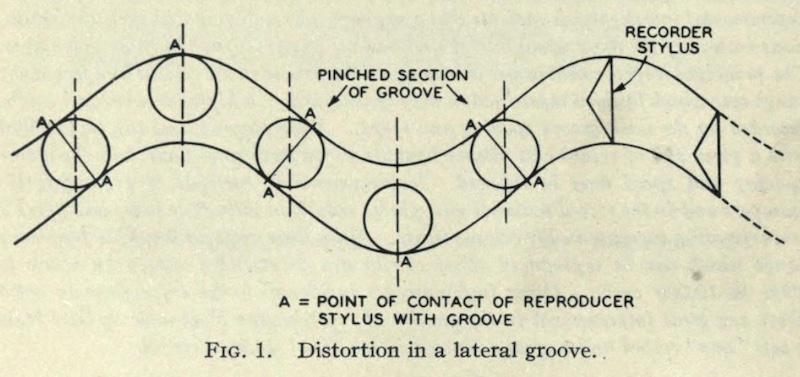
source: “Vertical Sound Records”, Journal of the Society of Motion Picture Engineers, February 1932, p.142.
本稿 Pt.4 にも掲載した、1932年にベル研の Frederick 氏が発表した論文より。上の Pierce & Hunt の図版と比較するとより理解が進みます。
This figure from the 1932 paper by H.A. Frederick of Bell Labs – this and above figures complement each other for better understanding.
6.2.1 Groove Sidewall Support / 音溝の側壁による再生針のサポート
そもそも、当時のレコードや当時の再生環境では、スタイラス(再生針)が音溝の両方の壁に2点で接触している状態で再生されていませんでした。前述の通り、盤に練り込まれた抗摩耗剤によって鉄針が削られ、レコードの音溝にフィットしていき、横の壁にも、溝の底にも接した状態で再生が行われていました。
What’s surprising is that, with phonograph records and playback equipments of these days, the stylus was not always spported by the sidewalls of the groove. As we have seen previously, the steel needle was ground by the abrasive in the record to get the stylus to fit the groove, then the tip of the stylus reaches the bottom of the groove.
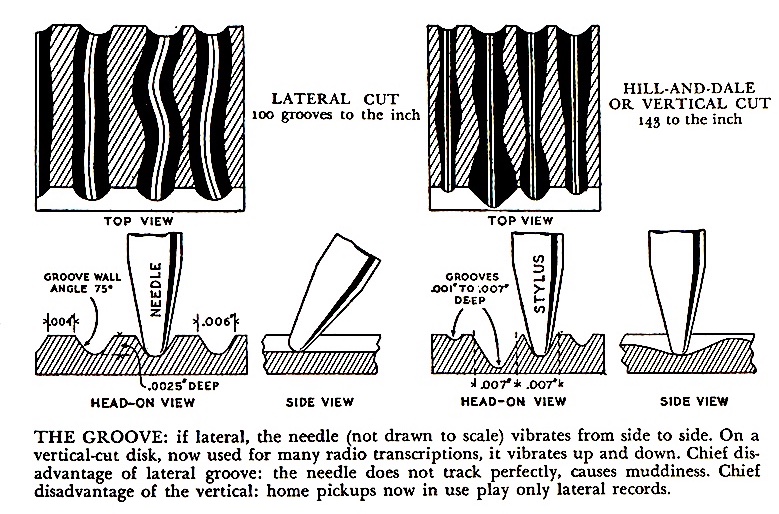
source: “Phonograph Records”, Fortune magazine, September 1939, p.75
本稿 Pt.5 でも紹介した、Fortune 誌に掲載された特集記事より。横振動盤(左)、縦振動盤(右)ともに、針と溝の接触が音溝の壁ではなく、むしろ溝の底に近いところとして描かれているのが分かります。
This illustration shows that the stylus sits onto the bottom of the recorded groove, not on the side walls of the groove, both on lateral / vertical records.
この論文では、横振動盤において、スタイラスが左右2点で溝に接触するべきであると示しています。そして、それを実現するためには、より軽針圧で再生できるピックアップが必要である、と結論づけています。この提案自体が、当時としては画期的な内容であったと言えます。
So in this paper, the authors concludes that the ideal lateral reproducer’s spherical stylus should be supported by the sidewalls of the groove, and in order to accomplish this, the pickup should exert extremely light forces (needle pressure) upon the groove wall. This suggestion by Pierce & Hunt was really innovative at the time, and became the breakthrough for the high fidelity reproduction of phonograph records that leads to our century.

source: “Elements of Sound Recordings”, p. 250, by John G. Frayne and Halley Wolfe, 1949.
45度の両壁に対しピンポイントで接触する、理想的な状態の再生針
そして、このような理想的な再生条件を備えた場合、図6の通り、全周波数帯域において、縦振動盤に比べて横振動盤の方が圧倒的に低歪で再生可能であることが理論上・実験上で示されたのです。
And consequently, with such an ideal reproducer, lateral-cut records produce far less distortion in entire frequency range, than vertical-cut records do, the authors concludes, theoretically and practically.

source: “Distortion in Sound Reproduction from Phonograph Records, J.A. Pierce and F.V. Hunt, Journal of the Society of Motion Picture Engineers, Volume XXXI, Number 2 (August 1938), p.173
上のグラフが、33 1/3回転の、中心から8インチの位置および4インチの位置の記録における、縦振動盤と横振動盤の高調波歪量をプロットしたもの。下のグラフは78回転の、中心から6インチおよび2インチにおける高調波歪量をプロットしたもの。いずれも横振動盤の方が高調波歪量が非常に少なくなっている。
米国物理学協会 (AIP, American Institute of Physics) のサイトに 1965年1月8日に行われた F.V. Hunt 氏への長編インタビュー が掲載されています。業界を震撼させた1938年の論文について、その背景や当時の事情について、実に生々しい証言が飛び出す、読み応え満点のインタビューです。
AIP (American Institute of Physics) website has a very interesting content, a long oral history interview with F.V. Hunt on January 8, 1965. Mr. Hunt himself describes the background as well as the scene when he and Mr. Pierce published the 1938 paper – really fascinating.
Hill and Dale. And, other transcriptions made lateral. And this was a very lively commercial competition.
そう、縦振動盤は「高低盤」(Hill and Dale) と呼ばれていた。そして、それ(World Broadcasting Company が Western Electric 社製の機器で製造した盤やその他)以外は、横振動盤だった。当時は主導権争いの真っ最中だった。
Here we came into a meeting — it was first presented at a meeting of the Society of Motion Picture Engineers — and said Hill & Dale has got all the Second Harmonics; laterals has got the push pull and no second harmonics. And in effect this paper tipped the scales and within a year the Hill and Dale transcription records almost disappeared.
で、我々はSociety of Motion Picture Engineers の会議に参加し、縦振動盤には2次高調波歪があるが、横振動盤はプッシュプルなので2次高調波歪がない、と発表した。で、この論文が事実上のきっかけとなり、縦振動盤は(トランスクリプション盤)市場からほとんど姿を消すこととなった。
They came up with a very neat tour de force in answer that if you re-recorded the Hill & Dale record with the polarity of the recorder reversed, you could in effect predistort the signal and get the effect of the push pull. And so we asked them the embarrassing question, yes, but do you do that in your commercial recordings and this question was dodged, so that in effect this paper shook the phonograph industry. And it was one of the few papers up to that time that had dealt with the phonograph playback process on a physical basis, on what you might call a scientific basis.
縦振動盤派は、レコーダの極性を逆にして再録音すれば、記録された歪が補正されて(横振動盤と同様の)プッシュプル効果が得られる、と非常に巧妙な回答を導き出した。そこで我々はこう問うてみた。「確かに、しかし、市販レコード用向けの録音でそんなことをするおつもりですか?」と。この質問ははぐらかされたが、結果、蓄音機・レコード業界を揺るがすことにつながった。当時、我々の論文は、レコードの再生プロセスを「物理学的に」、まぁ「科学的」といっても良いが、そのように扱った数少ない論文であった。
Jack and I had a lot of fun with that paper. This put us in a unique position — as academics, we had no commercial axe to grind, and therefore we could freely say to any manufacturer, you don’t know what you’re talking about. On a statistical basis with phonograph manufacturers you can make money betting that. And he knew that we weren’t saying it because we were trying to sell something in competition. As a consequence, we could talk with almost all the manufacturers who would tell us what they were doing.
Jack (Pierce) と私はこの論文を大いに楽しんだ。この論文のおかげで、我々は独自のポジションにつくことができたからだ。我々はアカデミックな世界の学者の立場であり、商業的な利害関係とは無縁で、どのメーカに対しても「いい加減なことは言わないでもらえますか」と自由に言い放つことができたのだ。我々が他社との販売競争をしようとしているわけではない、と皆分かっていたからだ。蓄音機メーカは統計的根拠に基づいて稼ぐことができる。また、結果として我々は、ほぼ全ての蓄音機メーカと話ができ、彼らは何をやっているのか聞くことができた。
Oral History Interview: Frederick Hunt - Session II (interviewed by Leo Beranek and Charles Weiner), January 8, 1965 at Harvard University6.3 Advent of Light Weight Pickup / 軽量ピックアップの誕生
レコード再生時における高調波歪を初めて数学的・物理学的・科学的に分析し、同時に横振動記録レコードの優位性を証明した Hunt 氏と Pierce 氏はさらに、その論文で言及されていた、横振動レコードの理想的な再生を実現するために、現代に至るレコード再生技術における重要な研究と開発を行っていました。当時としては画期的に軽量な針圧で再生可能なトーンアームとピックアップ です。
Hunt & Pierce, who proved the advantages of lateral-cut recordings over vertical-cut recordings by mathematically/physically/scientifically analyzing harmonic distortion in the disc record reproduction, accomplished another research and development that led to the excellence of our modern disc record reproduction technology. It was a ultra lightweight tonearm and pickup that no other pickups (at the time) could not do.
その研究成果は、Electronics 誌の1938年3月号に “HP6A: A Radical Departure in Phonograph Pick-up Design” として掲載されました。そのピックアップのクローズアップ写真は、当該 Electronics 誌の表紙も飾っています。
Their research was published on March 1938 issue of Electronics, entitled “HP6A: A Radical Departure in Phonograph Pick-up Design”. The close-up photo of their newly invented pickup also appears on the cover page of the issue.
6.3.1 Only 1 to 5 grams of needle pressure / たった 1〜5g の針圧
どのくらい軽いかというと、当時の蓄音機・電蓄・トランスクリプション再生機のピックアップの針圧が 2オンス (約56.7g) 〜 6オンス (約170g) くらいだったところ、Hunt & Pierce 氏の開発したトーンアームとピックアップ(カートリッジ) HP6A の場合は 5g(約0.17オンス)〜15g(約0.53オンス)程度でした。サファイア針が採用されていました。
How light was the needle pressure of this newly developed pickup? While the needle bearing weight (needle pressure) of common phonographs and transcription reproducers falls between 2 ounces (approx. 56.7g) and 6 ounces (approx. 170g), the newly developed HP6A requires only extremely light pressure between 5g (approx. 0.17 ounces) and 15g (approx. 0.53 ounces). The tip of the stylus was sapphire.
論文見出しには「信じられない周波数応答、30Hz から 18,000Hz まで ±3dB でフラット、針圧はたったの 5g、ベロシティマイクの原理を使って実現」とあります。
The headline of the paper reads: “Unbelieveable response, flat within plus or minus 3 db, from 30 to 18,000 cycles, with a needle pressure of 0.17 ounces, has been achieved by applying velocity-microphone principles.”

source: “HP6A: A Radical Departure in Phonograph Pick-up Design”, F.V. Hunt and J.A. Pierce, Electronics, March 1938 (archived at World Radio History), p.9
HP6A 論文の冒頭のページ
本論文の冒頭は、以下のような書き出しから始まっています。戦後にシェラック盤からヴァイナル盤に変わる時代を先取りしており、また現代に至るレコード再生技術の萌芽が見事に説明され尽くしていると感じます。
The paper starts off like the following. I believe this paper takes many new technology in advance, before switching from the coarse-groove shellac 78rpms to the fine-groove vinyl records. Also it definitely describes the advent of high quality and modern disc playback technology.
Much has been written in the technical literature during the past few years regarding the service and fidelity limitations of instantaneous recordings. It has been claimed, for example, that frequencies higher than 6,000 cycles cannot be recorded and that even if such frequencies could be engraved on the record they would be erased within the first few playings.
この数年間、ラッカー(アセテート)即時録音機の限界について、使用可能な寿命、また再生音質に関する多くの技術文書が書かれてきた。例えば、ラッカー盤には6,000Hzまでしか記録できない、あるいは音溝に記録できたとしても、それらの高周波数帯域の微細な記録は、数回再生しただけで消えてしまう、と主張されている。
In the field of commercial pressings intended for home consumption it is sometimes asserted that a wide frequency range would not be desirable, even if it could be secured, on account of the accompanying high noise level. This high noise level is in turn explained by the necessity of including an abrasive in the shallac pressing material so that the needle tip will be ground quickly to fit the groove contour. Even when so fitted the needle tip bearing pressure remains far above the elastic limit of the record material; both needle and record groove wear rapidly, and the initially high noise level steadily increases.
家庭用の市販プレスの世界では、周波数帯域を広くとれるようになったとしても、それに伴いノイズレベルが高くなるため、そもそも広周波数帯域記録は望ましくない、と主張されることもある。これは、針先が音溝にすばやくフィットするよう、シェラック盤に抗摩耗充填材(研磨剤、抗摩耗剤)が練り込まれていて、ピックアップの針が削られていくからである。そうやって針先が音溝にフィットしたとしても、針圧すなわち針先から受ける軸受圧力は、レコード素材の弾性限界をはるかに超えているため、針とレコード溝は急速に摩耗していき、高周波数帯域でのサーフェスノイズが増加していく。
It is the writers’ belief that these limitations on fidelity and service life should be charged principally to the reproducers which have been available rather than to the recording and pressing materials. If a simple and rugged reproducer could be constructed which would have low needle-point impedance and operate with extremely low needle pressure, several advantages would immediately be gained. The abrasive could be ommited from commercial pressings and both these and the lacuqer-coated instantaneous discs would offer high-fidelity, low-noise reproduction with long service life, either in the studio or in the home.
筆者らは、音質や使用可能な寿命に関するこのような制限事項は、録音技術や版のプレス素材によってではなく、主に再生機側によって改善可能であると考えている。もし、針先のインピーダンスが充分に低く、また針圧がきわめて軽い、そんなシンプルで頑丈なフォノピックアップを作ることができれば、複数の利点が今すぐにでも得られるだろう。市販のシェラック盤に抗摩耗剤を混合する必要がなくなり、シェラック盤であっても、ラッカー(アセテート)レコーダでカッティングされた盤であっても、つまり家庭でもスタジオでも、高音質、低ノイズ、長寿命の再生が可能になるのである。
HP6A: A Radical Departure in Phonograph Pick-up Design, F.V. Hunt and J.A. Pierce, Electronics, March 1938, pp.9-12Pierce & Hunt 氏の研究開発はさらに続き、1941年の HP26A ピックアップでは、ほぼ現代と同じレベルの針圧と言って良いであろう、針圧 1g での再生を可能にしました。
Further research and development by Pierce & Hunt continued: their HP26A pickup, developed in 1941, required only one gram of stylus pressure.
(…) it was good old HP6A on the cover of Electronics in 1938, and the model that was our ultimate achievement was an HP26A. And we’d used all the numbers in between. And in 26A, we had dropped the weight—this would have played at one gram. The equivalent mass referred to the stylus of that 1941 pickup was less than one milligram, and only now are the best deluxe pickups getting down to the equivalent mass we had in 1941.
(…) 1938年の Electronics 誌の表紙を飾ったのは HP6A ピックアップだが、我々の究極の到達点となったのは HP26A ピックアップだ。6 から 26 の間の数字のモデルも開発した。そして 26A ピックアップではさらにピックアップ質量を減らし、1グラムの針圧で再生可能になった。スタイラス部分の質量は1ミリグラム以下であった。(このインタビューが行われた1965年)現在の最高級ピックアップでやっと、我々が1941年に達成した質量や針圧に相当するところまで到達してきた。
Oral History Interview: Frederick Hunt - Session II (interviewed by Leo Beranek and Charles Weiner), January 8, 1965 at Harvard University6.3.2 Virtually Infinite Record Life / 事実上ほとんどレコードを摩耗させない再生
従来の鉄針での再生、またはクロム針やサファイア針であっても、50g〜170g程度の重針圧で再生した場合、特にラッカー盤(アセテート盤)の再生では、たとえ音溝に 6,000Hz 以上の周波数が記録されていたとしても、数回の再生でその微細な溝が摩耗してしまっていました。それが、新しい軽針圧のピックアップでは、たとえラッカー盤であっても、溝が簡単に摩耗することなく、従来と比べればほぼ半永久的と言って良いほど再生可能になりました。
With steel needles, chrome needles, or even sapphire needles, phonograph (shellac) records and lacquer (acetate) discs will be easily damaged after a few playback, when the needle pressure is as heavy as 50g to 170g. Even though the sound groove can contain higher frequencies over 6,000Hz, it will be worn out easily with heavy pickups. However, newly developed ultra-light pickup can safely reproduce instantaneous lacquer discs (which are less sturdier than commercial records) virtually without any noticeable wear.
その結果、従来の鉄針での再生を前提として、シェラック盤に練り込まれいていた抗摩耗充填材(研磨剤、抗摩耗剤)によって、針が削れることで安定したトレースを可能にする(結果としてサーフェスノイズが盛大に発生する)のに比べ、針先が音溝の底に到達せず、常に溝の左右の壁に乗った状態になり、高域の再生もよどみなく行えることが検証されました。
As a result, compared with regular playback, where abrasive compounds in shellac records grind the stylus to fit it in the sound groove (and as a result surface noise occurs), the stylus of the new lightweight pickup won’t reach the bottom of the groove, fitted on sidewalls, resulting in high fidelity reproduction even in high frequencies.
実際、この論文では、テスト用にカッティングしたラッカー盤を、今回新しく開発した6Aピックアップで最初に再生した際の周波数特性 (A)、同じ6Aピックアップで100回再生したのちの周波数特性 (B) が掲載されており、100回再生したのちでも、その周波数特性は全く変わらず、ノイズレベルも一切変わらなかったことが確認されています。そして同じラッカー盤を、当時の放送局用ピックアップ(針圧は3オンス≒85g)で50回再生した後に、6Aピックアップでふたたび再生した際の周波数特性 (C) は、4,000Hz 以上で(音溝が摩耗したことによる)減衰がみられ、同時にノイズレベルが9dBも増えてしまったことが確認されています。
As a matter of fact, this paper presents the result of an interesting test: lacquer-coated test record (33 1/3rpm) with the frequency sweep was played with the new ultra-lightweight HP6A pickup (line A), then was played 100 times (line B). Frequency responses and surface noise levels of A and B was the same. Then the same disc was played with lightweight transcription pickups (tracking force of 3 ounces) 50 times, and calibrated the frequency response with the HP6A pickup (line C). As a result, groove wear was obvious over 4,000Hz, and noise levels over 12,000Hz largely increased of 9 dB.

source: “HP6A: A Radical Departure in Phonograph Pick-up Design”, F.V. Hunt and J.A. Pierce, Electronics, March 1938 (archived at World Radio History)
AおよびB (実線) が、ラッカー盤を新型ピックアップで100回再生したあとの周波数特性、C (破線) が、そのラッカー盤を当時のトランスクリプション盤用ピックアップで50回再生したあとの周波数特性
この論文で発表された、開発されたトーンアームとサファイア針の現物は、現在でもハーバード大に保管されているそうです。
This revolutionary invention is still in possesion of Harvard University.
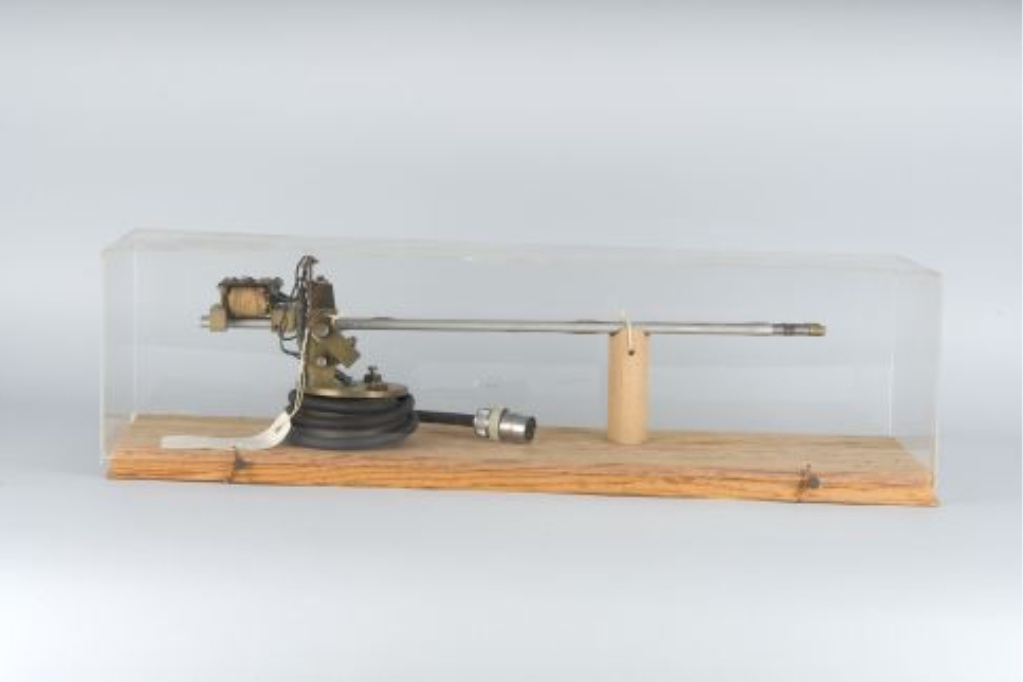
source: “HP6A tone arm and magnetick pickup”, Collection of Historical Scientific Instruments, Harvard University
また、このピックアップの技術は、US2239717A “Electromechanical-conversion device” として1938年に特許申請されています。
Also, this technology’s patent was applied and filed in 1938 as US2239717A “Electromechanical-conversion device”.
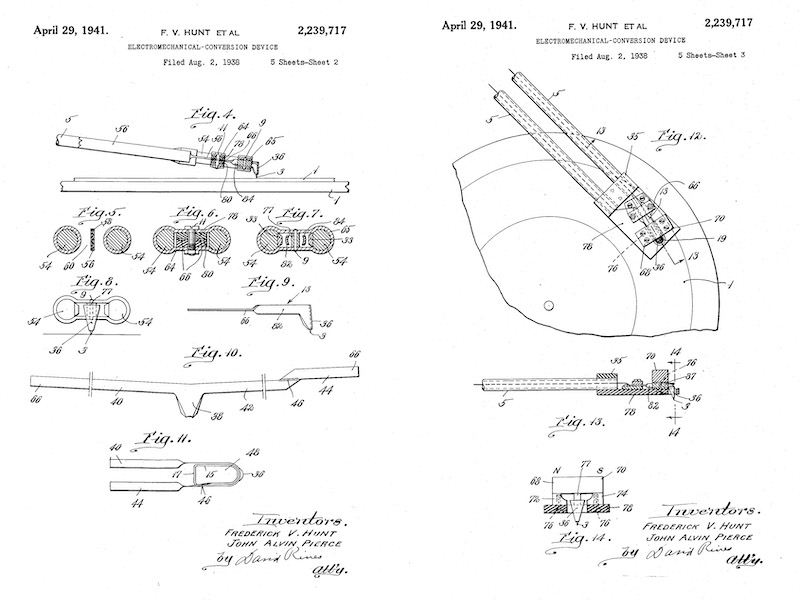
source: “Electromechanical-Conversion Device”, F.V. Hunt et al, US Paten 2,239,717.
Hunt 氏の特許申請書類に掲載された図版の一部
上でも紹介した 1965年1月8日に行われた F.V. Hunt 氏への長編インタビュー では、この HP6A ピックアップについての興味深いエピソードが紹介されています。
The long oral history interview with F.V. Hunt on January 8, 1965 also features a very interesting episode of the HP6A pickup he and Pierce invented.
We, moreover, concluded that that was the way you ought to play the record. That the stylus should not ride to the bottom of the groove, but should be supported on the side walls. That was the only way you could be sure where the stylus was with respect to the groove.
我々はさらに(この研究開発を通して)、レコードがどのように再生されなければいけないか、を結論づけた。つまり、再生針は、レコードの音溝の底に接してはならず、音溝の左右の壁にサポートされた状態で再生されなければならない、ということだ。この状態が保たれることで、針が音溝を忠実になぞることが保証されるということだ。
And, prior to this time, there were only shellac records available at that time, and always the legend was that there was abrasive in the record so that it would grind the stylus to fit the groove. Actually there wasn’t any abrasive, it was just the clay fillers they used in the shellac, but it did serve the purpose of abrasive.
そして、(我々がHP6Aピックアップを開発する)前には、(市販用レコードとしては)シェラック盤しか存在しなかった。そして、再生針(鉄針)が音溝にフィットするように、レコードには抗摩耗剤が練り込まれていた、と伝説のように言われていた。実際には抗摩耗剤なんてものはなかったのだが。実際にシェラック盤に混合されていたのは粘土質の充填材で、これが抗摩耗剤の働きをしていたということだ。
Well, this assumption of side wall support was necessary for the mathematical analysis. It was obviously the proper way to play a record and our pickup was the only one that was light enough to allow the stylus to be supported on the side walls without deforming the groove wall enough to ride on the bottom. So we had conceptioned and reduction to practice, and when we were applying for patents on the pickup we included some claims on the side wall support of the stylus.
この「音溝の側壁による再生針のサポート」は、数学的な分析のために必要であった。そして、これが明らかに適切なレコード再生方法であったし、我々の開発したピックアップは「針が音溝の左右の壁にサポートされ」「音溝を削ったり変形させて針が音溝の底に到達しない」、十分に軽量なピックアップとして当時唯一のものであった。そこで、コンセプトを練り、ピックアップの実用化までもっていったのち、特許を申請する際には、音溝の側壁による再生針のサポートに関する主張も盛り込んでおいた。
And the reason I mention this is that this is the fortune that Jack and I eschewed and gave up to the phonograph industry because we both got distracted by war research, the patent came out during the war, and by the time the war was over it had already been late, we had abandoned it, we never sued anybody. If we had been careful about picking some small fellow and suing him and getting the claims validated, I think we could probably have made a lot of money from the side wall support, because by the time the war was over everybody took it for granted that, of course, the stylus was supported on the side walls of the groove, how else would you do it? And without realizing that—in 1938—this was not only novel but no other pickup could do it except our experimental job. (…)
なぜ今この話をしているか、というと、Jack (Pierce) と私の2人は当時戦時研究に追われていたため、蓄音機業界に見切りをつけた、そういう運命だったからだ。HP6Aピックアップの特許は第二次大戦中に発行されたが、戦後にはすでに遅きに失していたため、我々はその特許を放棄し、誰も訴えることはなかった。戦争が終わった頃には、再生針は音溝の側壁でサポートされているのは当たり前のことだ、と誰もが思っていたから、もしも我々が当時、側壁サポートに関する我々の特許を侵害している、と訴えを起こしていたら、その特許で大金を稼ぐことができていたであろう。実際には、再生針の音溝側壁サポートは、(我々が特許を申請した当時の)1938年においては斬新であっただけでなく、我々による実験的な開発によって生んだ HP6A ピックアップ以外では不可能なことであった。 (…)
(…) The pickup never was (picked up commercially soon). The side wall support was picked up almost immediately after the war.
(…) 我々のピックアップが市販されることはなかった。側壁サポートという点だけが終戦直後に次々と採用されていった。
Oral History Interview: Frederick Hunt - Session II (interviewed by Leo Beranek and Charles Weiner), January 8, 1965 at Harvard University6.4 The summary of what I got this time / 自分なりのまとめ
今回も予想以上に長くなってしまいました(笑)。ラッカー盤(アセテート盤)の登場と、当時それら用に使われていたカッターヘッドの特性について学びました。また、縦振動記録に比べて横振動記録の方が有利であることを示した論文、および当時としては画期的な軽針圧で高音質再生可能なピックアップの開発についてもみてきました。
Well, in this Part 6 article (yet again, it became a way longer than I initially intended…), I have learned so many things about the advent of instantaneous lacquer discs; cutterheads used for lacquer discs and their frequency response; the technical paper that proves the superiority of lateral-cut recordings over vertical-cut recordings; and revolutionary ultra-lightweight (at that time) pickup for higher fidelity.
さてさて、今回の内容をざっくりまとめると、こんな感じでしょうか。
…so, the rough summary of my understanding in this article would be something like this:
1934年頃に英仏米の各社から、ニトロセルロースをアルミ盤に塗布したいわゆるラッカー盤(アセテート盤とも言われる)が発表。Presto のポータブル即時録音再生機(アセテート録音機)の大ヒットとあいまって、ラジオ業界、フィールドレコーディング、エアチェック、まれにプレスディスク原盤作成目的として、広く使われた。
From around 1934, several companies in UK, France and the US started distributing lacquer discs – aluminium discs coated with cellulose nitrate and other compounds. Along with the good sales of Presto’s portable instantaneous disc recorders, lacquer discs and disc recorders were widely used for instantaneous transcriptions in the radio industry, for field recordings, for airchecks, or sometimes even for making press masters for commercial discs.
代表的な Presto 1-B〜1-D カッターヘッドでは、裸特性に簡単な補正回路を加え、ベースターンオーバー周波数である 500Hz より下は定振幅、上は定速度の記録特性を得ていた。さらにそこに補正回路を加え、例えば放送局向けの Orthacoustic 特性(のちの1942年 NAB カーブ)を得ていた。記録特性の調整は基本的に回路改造で行われていた。
Typical cutting heads for instantaneous recorders at the time, Presto 1-B to 1-D, obtained the recording characteristic of “constant amplitude (6dB per octave slope) below 500Hz” and “constant velocity above 500Hz”, by adding a simple compensator network. Furthermore, with additional compensator network(s), Orthacoustic curve (for radio transcriptions, later becoming 1942 NAB curve) was obtained. Fine-tuning of the recording characteristic was made with circuit modification by soldering etc.
1938年に発表された Pierce & Hunt の論文で、高調波歪の点で横振動記録レコードの方が圧倒的に優秀であることが物理学的・数学的・科学的に証明された。同時にこの論文に関連して、当時としては超軽量な 1g〜5g という針圧で再生可能なピックアップ HP6A と HP26A も開発され、高品質な再生のためには針が溝の側面にサポートされた状態である必要があることが示された。これは、現在のレコード再生の基礎となる技術である。
The 1938 technical paper by Pierce & Hunt physically/mathematically/scientifically proved that the lateral-cut records were far superior to vertical-cut records: when properly reproduced in ideal situation, lateral-cut record produces far less distortion. Also along with that paper, they invented the ultra-lightweight pickup system HP6A (5 grams of needle force) and HP26A (1 gram); and they showed the groove’s sidewall support of the stylus is essential for high fidelity reproduction, which is one of the key technology of modern disc record reproduction.
次回は引き続き歴史を辿り、クリスタルカートリッジの登場、1942年 NAB 統一カーブ策定あたりについて学んでいきます。
My next post will feature the continuing history, including the advent of crystal pickups, as well as the first NAB standardization for transcription discs in 1942.
» 続き / Sequel: “Things I learned on Phono EQ curves, Pt.7” »

